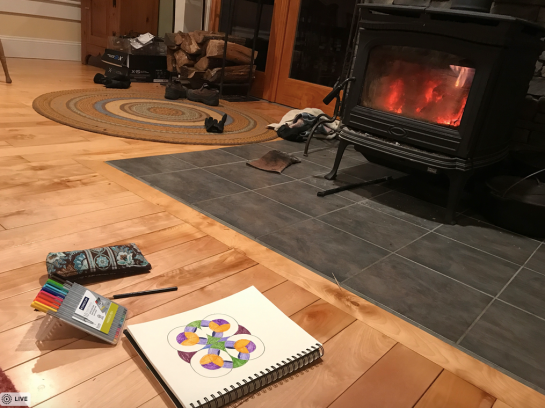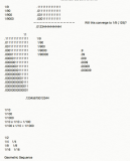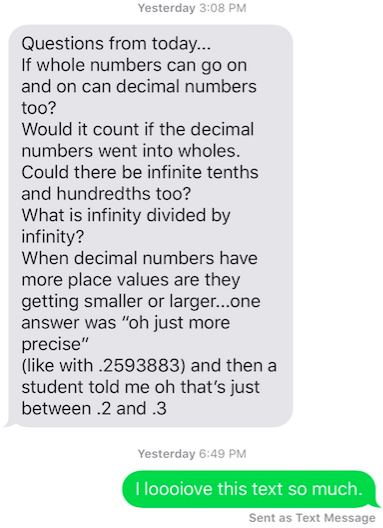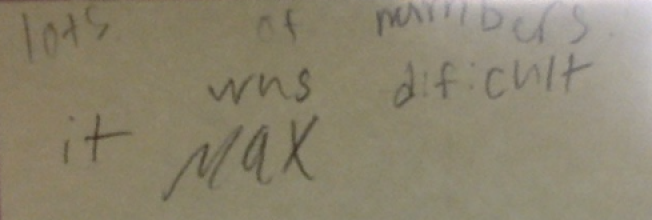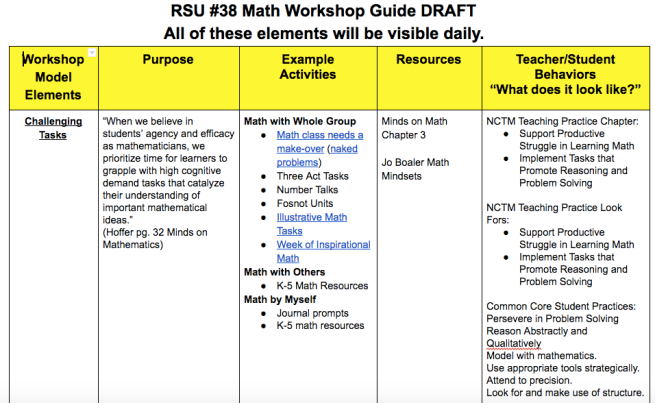Last weekend, I wrote about my experience doing Number Talks in two high school classrooms. I got some really helpful feedback.
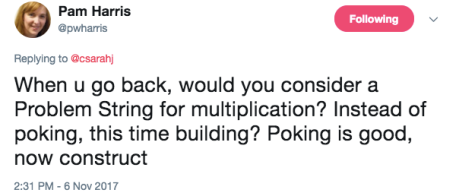


After I read the blog post Pam recommended, I read the pages from her book that were referenced in the blog post. Then, I started to plan the string I would use in the Transitions to Algebra class. I thought about, why would I use the string Pam recommended? How does that string fit with what we are trying to do with our students?

Then, I anticipated what our students would do and say when I presented the first problem in the string:

So, that is how I planned to introduce the string. Here is how it actually went down:
When I walked into the classroom, Ms. S wasn’t there. The bell hadn’t rung yet. All nine students were scattered around the room. Some were sitting in pairs and others sat by themselves. I told the students how glad I was to be back. As I connected the Smartboard, to my computer, I chatted with the students. I checked in with each of them to see if I remembered their names correctly. A group of girls tested me.
I asked their friend, “I can’t remember, is your name Megan or Meegan?”
They laughed and said, “Megan”.
Someone said, “no. Her name is Meegan.”
More laughter.
At this point, Ms. S came back in the room. As soon as she sat down across from Riley, he looked at her and said, “I hate math. I just hate it.” Ms. S reminded Riley how hard he had been working and how much he is learning this year.
I asked her, “Is it Megan or Meegan?”
She said ,”Meegan.”
“Thanks.” Then, I officially started my lesson. “So, last time I was here we were doing some multiplication. Today, I planned a Number Talk that is a little different. Today’s Number Talk problems are going to be about a situation. We are going to talk about bags of m&ms. Not the big bags. The little ones.”
Ms. S chimed in, “The fun size bags.”
“I have one of those!” Hayley said, as she dug into her sweatshirt pocket. She held up a little red bag. “Forget it. These are Skittles.”
Several students erupted, “Let’s do Skittles. I hate m&ms. Skittles are so much better than m&ms.”
“Not today,” I said, “maybe next time we will talk about Skittles. I am so glad Hayley had a bag of Skittles in her pocket because the m&m bags look a lot like the Skittles bag. Now we all have a clear idea of the size of the bags. Thanks for adding to our context, Hayley.”
“Okay. So , today, I want you to consider bags of m&ms. Each bag of m&ms has 17 m&ms in it.” I wrote in the table as I spoke:

“Think about how many m&ms would be in 2 bags. Please don’t say your answer out loud. You don’t have to raise your hand. Remember, you can show me a thumb when you have a possible solution.”
Some of the kids held thumbs in front of their chest. A few kids raised their hands. Meegan blurted out, “like 30.”
I said, “So Megan…”
Laughter. I looked at Ms. S and she said, with a smile, “it’s Meegan.”
I smiled, “See what happens when you mess with me? I have trouble remembering names when I hear them correctly the first time.” I continued, “So Meegan, can you use your thumb next time. I totally appreciate that you are participating, but I want to make sure everyone in the room gets enough think time.” I wrote her solution on the smart board.

“Are there any other solutions?”
“30 something.”
I was about to ask Riley why he said 30 something, but Max started talking, “34 because 10 plus 10 is twenty and 7 plus 7 is 14 and 20 plus 14 is 34.” As Max was talking, I started recording what he was saying:

In the middle of Max’s explanation, Riley started a monologue of verbal processing, “No. I did 20 plus 7 is twenty-seven, but now I have to add seven more and I lost count. You need to add the 7 to the twenty….”
I need you to picture those conversations happening simultaneously, while Meegan is having a side conversation with Katie and drawing on her hand. I wish I had an audio of it.
The two boys were talking at the same time. They weren’t trying to be difficult. They weren’t intentionally ignoring each other. They were just being impulsive. My greatest struggle with this class is that they are incredibly impulsive. If you know me at all, you can feel free to chuckle right now. I get it. The impulsive leading the impulsed.
“Okay,” I said, “hold on. I really want to hear all of you and I want you to hear each other.” At this point, Ms. S went over to Meegan and asked her to put the marker away. I continued, “Max was telling me that he thinks the answer is 34 because he added 17 plus 17 by decomposing the 17s. Max, did I record your thinking correctly?
“yes.”
“Okay. Riley, it sounds like you did not solve the problem that way. Am I correct?”
“Hold on,” Riley said, “Ten plus ten is twenty and then plus seven is twenty-seven. Now, I have to add 27 plus 7. Ugh. That is the worst. 27, 28, 29, 30, 31, 32, 33, 34. Okay, yeah, 34.”
I tried to record his thinking:

I asked, “Does my recording represent what you were thinking?”
“yes.”
“Okay. So, we just spent a lot of time talking about addition. Can anyone see a multiplication problem in this situation that we are talking about?”
Matt said, “17 x 2”
Riley asked, “Is that the same as 2 x 17?”
“Yes!” Said Ms. S. Later, Ms. S told me that Riley has been thinking about the commutative property a lot lately.
“Okay,” I said, “so we can say that 17 + 17 = 17 x 2?”
“yes,” they agreed.

Next, I asked, “What if there are 4 bags of m&ms?”
Olympia blurted out, “41”.
I recorded it and reminded her to please show me a thumb.
I think she said, “sorry.”
I saw a few thumbs and a few raised hands. Several students, to include Samantha, had yet to participate. I asked Porter, “Do you have a solution? You can pass if you want, but I would love to hear what you are thinking.”
“pass.”
“Hayley, do want to share a solution?”
“pass.”
Riley said, “I got 68.”
Hayley said, “me too.”
Olympia said, “I got 41. It’s wrong.”
Riley added, “I think you only added one 17.”
Max and Matt were having a side conversation about why the answer wasn’t 41. Meegan and Katie were giggling about something that I am pretty sure had nothing to do with math. I was trying desperately to NOT lose the exchange that just happened between Olypia and Riley.
“Riley, are you saying that you think Olympia got 41 because she only added one bag of m&ms, instead of two?”
“Yeah. She only added one 17. She needs to add another one.”
“Okay! So we can add that to our table. Where can I put that?”
“you can put a 3 in between the 2 and 4.”
I did.

So… I did NOT anticipate this conversation happening. That might be why I didn’t actually notice that 34 plus 17 is NOT 41. It is 51. I was so excited that Riley was thinking about Olympia’s mistake in the context of the problem that I didn’t even catch the arithmetic mistake.
Keep in mind, Meegan is still having a side conversation. Samantha is drawing on her whiteboard (where did she get a marker?). Max and Matt are explaining their solutions to each other, completely ignoring the rest of us. Oh…. and Bill, Hayley, and Porter haven’t said a word in a long time.
“Can everybody listen for a second?” I asked. “I absolutely love coming into this class to do Number Talks with you. It is the highlight of my week. I learn so much from you, but I get really frustrated when you are all talking at once. I want you to be able to hear each other. Can we please try to take turns when we talk?”
It got quieter. It was not totally silent, but everyone was making eye contact with me and attempting to pay more attention then they were before I started speaking. I’ll take it.
At this point, I asked, “where is the multiplication in the work we are doing?”
Matt mentioned doubling again. I asked him to show me where the multiplication was, in regards to doubling.
He explained, “17 x 2 is 34 and 34 x2 is 68.”
We continued to discuss the amount of m&ms in eight packs.

Then, I asked about ten packs. Several students said, “170.”
Riley said, “one hundred something.”
I asked, “how do you know it is one hundred something?”
He explained, “well ten times ten is 100, but then I have to add ten sevens and I can’t do that in my head.”
Matt said “dude, you don’t have to do that. There is a much easier way. Whenever you have something times ten you just add a zero to the number. Seventeen times ten is seventeen plus a zero. It is 170. You are making it harder than it needs to be.”
I said, “okay, can we slow down a second? What Riley is saying and what Matt is saying actually go together. Matt is talking about the procedure and Riley is talking about why the procedure works. Riley, can you repeat what you started to say?”
As he spoke, I drew an area model on the board.

Halfway through my drawing, Matt spoke up again, “you don’t have to do all that. You just add a zero. You are making it harder than it needs to be.” Matt is not trying to be disrespectful. Matt is trying to help his classmate.
I said, “Matt, you are trying to show Riley a trick that helps you. Riley is trying to understand where the answer is coming from. I think Riley’s strategy is connected to what you are saying.”
Riley said, “I just don’t know 7 times 10.”
Meegan said, “it is 70. You just add a zero.”
Riley agreed, “Oh yeah! Okay. Yeah. The answer is 170.”
At this point, I REALLY wanted to revisit the commutative property with Riley, but there was so much else to consider. Matt was getting frustrated that we were spending so much time discussing a strategy that, in his mind, was needlessly cumbersome. He wasn’t frustrated with his classmates. He was trying to help them. He was frustrated with me. He didn’t understand why I was “wasting” all this class time talking about something that had no relevance to him. Why didn’t I just tell Riley to “add a zero” and move on with the Number Talk? So, for better or worse, I moved on.
“Okay, let’s talk about 12 packs. Ms. S, can you give everyone a marker? I would like all of you to record a solution on your whiteboard. Try not to use the whiteboard to solve the problem, but use it to record your solution. I want everyone to at least try, please. You can write your answer really small, if you want. I just want to see something so I know that you tried.”
Right away, Meegan wrote 204 and then covered it. She looked up at me and whispered, “Do I have to keep it uncovered?”
I said, “I saw it. You can keep it covered it, if you want. Just don’t erase it.”
Hayley wrote twelve seventeens on her whiteboard and started to add them. Olympia had three hundred something written on her whiteboard. I can’t remember the exact number. I waited about 2 minutes. Hayley was still adding twelves. Bill hadn’t written anything but had that “mental math” look on his face (eyes looking at the ceiling, lips moving, head nodding in sync with a count,). Matt was describing to Max how he added 34 to 170. Meegan, Olympia, Samantha, and Kate were doodling.
“Okay,” I said, “you might not have a solution yet and that is okay. I want us to start a conversation about what we think so far. Meegan, can you tell us where you got 204?”
“I added 34 and 170.”
“Can you tell us why you did that?”
“Because that is 12.”
“What is 12?”
“204.”
“Twelve what?”
Meegan responded, starting to get frustrated, “you asked how many are going to be in twelve!”
“Right. I did. Okay. So you added the amount of m&ms in ten bags to the amount of m&ms in two bags?”
“yes.”
At this point, there was a lot of agreement about Meegan’s answer. Everyone thought it made sense.
“Okay,” I said, “Does anyone see a multiplication problem in the problem we just solved?”
For the next five minutes, we engaged in a round of Guess What the Teacher is Thinking. I hate this game and I try so hard not to end up playing it, but sometimes, I get caught off guard. The kids were not really sure what I was asking. I should have just said, “You told me that 2 bags of m&ms was 2×17 and ten bags of m&ms was 10×17. So…..” But I didn’t say that. I actually don’t remember what I said. I just remember the distint feeling that the kids were trying to guess what I wanted them to say.
I am not sure where it came from, but, eventually, Riley said, “so, do you mean twelve times what is 204?” I wrote it on the board.

“Let’s go with that. So, what did we multiply 12 by to get 204?”
This is where the lesson got really interesting. No one saw the 17. Meegan mentioned that she added 34 and 170. Matt and Max were discussing how they added 170 and 34.
I asked Hayley, “Do you mind sharing what was on your whiteboard before you erased it?”
She smiled and said, “It was so stupid. I am so stupid.”
I said, “I don’t think it was stupid. I don’t think you are stupid. In fact, I think it is going to really help us answer this question. Right now, we have an answer that we know makes sense, but we are struggling to figure out how to write the problem using multiplication. I think what you had written on your white board will help us. You can pass, but I would love it if you shared your work with us.”
She said, “pass.”
“Do you mind if I talk about what was on your white board?”
“That’s fine,” she agreed.
I said, “Hayley had the number 17 written on her white board 12 times,”
Riley interupted me, “It is 17! Of course it is 17. It is 12 x 17!”
“Yes,” I said. “It is 12 x 17. Hayley, your work was really important because you were the only one who thought about the problem as 12 groups of 17. We needed to hear about your work to remember that we are multiplying 12 x 17.”
Then, I asked, “Where is 12 x 17 in Meegan’s solution? Meegan said that she added 34 and 170. Where is 12 x 17 in her work?”
Matt said, “Well 10 plus 2 is 12 so there is the 12.”
I asked, “where is the seventeen?”
Somebody responded, “There is a 17 under the one, but that isn’t the seventeen that Meegan used.”
We had been Number Talk-ing for awhile. I decided to wrap it up. I drew another area model of 17×12. I explained that Meegan’s strategy works because of the distributive property. Our table showed 10 bags of 17 (or 10×17) and it also showed 2 bags of 17 (or 2×17). Meegan added the partial products to find out how many m&ms would be in 12 bags of m&ms.

I added that Riley was using the distributive property earlier when he decomposed 17 into 10+7.

Riley erupted, “can we call that ‘Riley’s Law’?”
“Sure,” I said. “It is also called the distributive property, but Riley’s Law works for me.” I wrote Riley’s Law next to the area models.
After class, I chatted with Robyn, the high school Math Specialist who has been collaborating with Ms. S. Robyn was in the math office and I asked if she had a minute to reflect with me. I described how our class went. I asked her to help me think about what we might do next time. Here are the notes I took:

After I chatted with Robyn, Ms. S came into the office. We started chatting.
She said, “I am sorry they were rude to you. I talked to them after you left. I have been wanting to revisit our classroom expectations. I told them if they acted like that next time, there would be consequences.”
I said, “We should also revisit our Number Talk expectations. How about next time we create an anchor chart that defines the purpose of the Number Talks and the expectations. We did that in September, but we didn’t write it down anywhere. Also, now that we have done several Nubmer Talks together, the conversation about norms and expectations will have more meaning.”
“I like that idea,” said Ms. S. “Can you lead that conversation? I would really like to see what it looks like. I will support, but I would love to watch you do it.”
“Sure,” I said. I took some notes as we processed the different behaviors we saw today and how they impacted our learning.

Then, I shared the conversation that Robyn and I had about the content of our next Number Talk. Ms. S agreed that the plan Robyn and I came up with would be a good next step. We both had to run to a meeting, but I am going to ask her if we can set up a time next week to anticipate student responses and create a monitoring sheet. Maybe Robyn can join us.
My favorite moments are when frenetic, seemingly unrelated experiences lead to serendipitous learning. This week, I engaged in several different reflective conversations on Twitter. One was about my high school Number Talks experience. Another was about teacher collaboration, and the third was about a little boy’s response during a Which One Doesn’t Belong routine. In my non-virtual life, I was reading chapter 11 of Tracy Zager’s book Becoming the Math Teacher You Wish You’d Had and facilitating several really hard conversations about why collaborative interventions are best for kids.
I wonder, how do I stay intentional when real life veers from my plan? I think, after writing this really long blog, the answer lies in honing my intuition. There are a million things I could have done differently during the Number Talk that I just described. Okay, maybe not a million, but I have thought of at least five just while I was writing this blog.
My best attempts at reflection usually involve finding a crossroad in the journey, revisiting the path I took, and exploring the path I might have taken. If the reflective process works, it leads me to a truer understanding of my intentions.
The most important teaching decisions are made in those micro seconds, when things don’t go as planned and we have to use our intuition to decide what to do next. My intention is to shine the light on those moments so we can all think about them together. I try to write about the messy stuff: the moments of uncertainty, confusion, and frustration. I try to write about the times when things didn’t go exactly as planned because, in my teaching and coaching experience, they never do.




